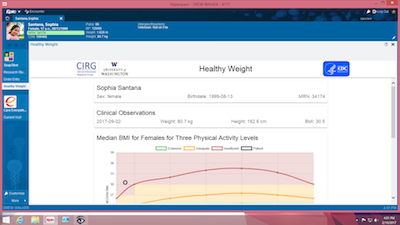
ID section
We've got the right patient, and echo back her height, weight, and BMI
The use case described a young woman, a health care worker with a diagnosis of obesity, who was seen by a primary care provider using the Epic EMR. While using Epic, her provider reviewed and updated her immunizations in the state registry, directly enrolled her in a clinical trial using a trials information system, referred her to an outside nutritionist, and provided anonymized population data to public health. In a subsequent visit, the patient was counseled on weight and healthy habits using both individual data from the nutritionist, and population data from public health tailored for her age, occupation, and sex.
All of the systems in the demonstration used standards-based interoperability, implementing IHE "profiles" to ensure that data were exchanged without dependencies in particular vendor products. Any vendor implementing the profiles could "plug in" and exchange health data.
 logos.png)
Here's a photo of the demonstration screen - a version of EpicCare configured for a primary care provider, showing the "Healthy Weight" tab, linked to the SMART on FHIR app. Photos of screens never come out that well, but this is so cool - the long sought after goal of public health making available a secure app, running inside the EMR, which blends patient specific information with public health knowledge.
Think of all the possibilities - not just for public health, but for patient reported outcomes, patient-centered interventions, integration of data from outside the EMR... But, more on the possibilities in a bit. For now, we have a few galleries of pictures to show you.
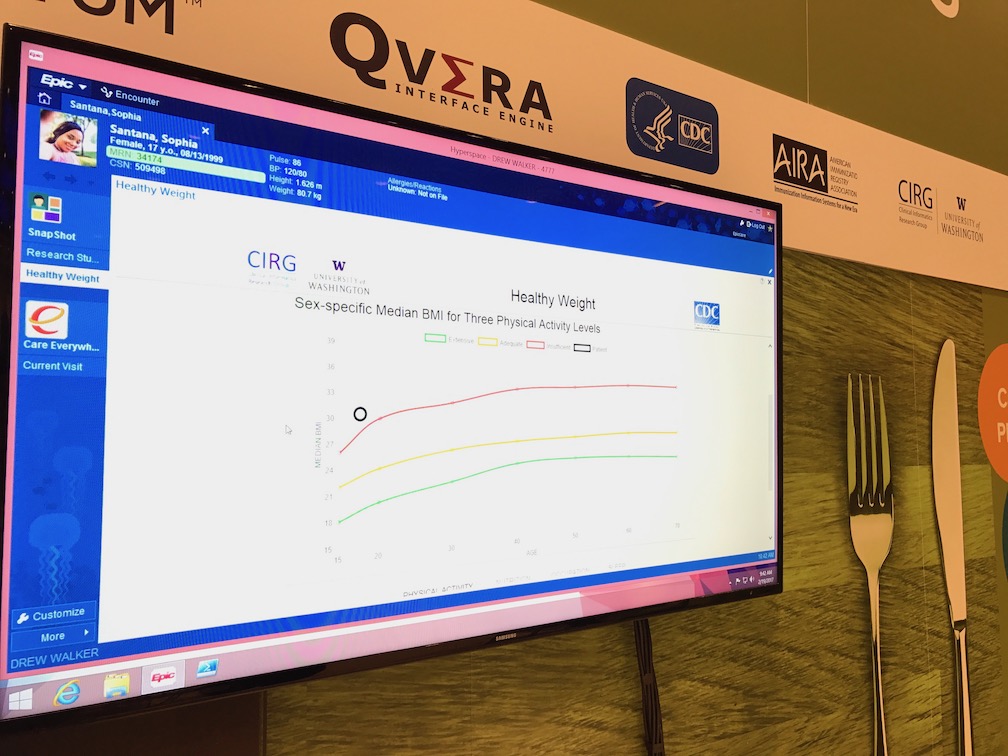
Below are some views of the SMART on FHIR app. We illustrated three features to give the provider information to motivate the patient to adopt healthier behaviors, and shed less healthy ones:

We've got the right patient, and echo back her height, weight, and BMI
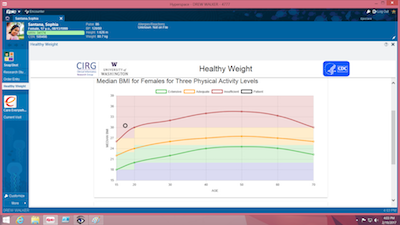
Notice the impact exercise can have for some women, at your age, and as they get older.
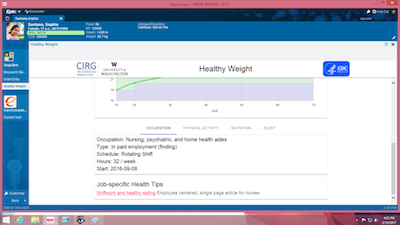
Details assessed in the nutrition consult.

Healthy habits and readiness to change.

Healthy habits, some less healthy ones, and readiness to change.
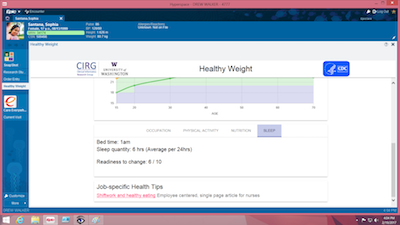
Sleep habits and readiness to change. Information for rotating shift-workers in healthcare.
HIMSS and the IHE Showcase are always interesting!
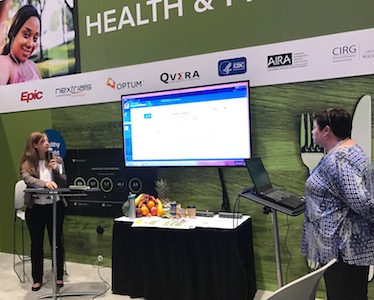
Lauren Snyder, UW PhD student and Terrie from Qvera
We told our story to about 15 audiences over three long days.

For the second year in a row, CDC staff brought healthy snacks to illustrate healthy habits.

Pascal Brandt, UW PhD student, with Danielle from Epic and a colleague of hers, wiring the SMART on FHIR app into EpicCare.
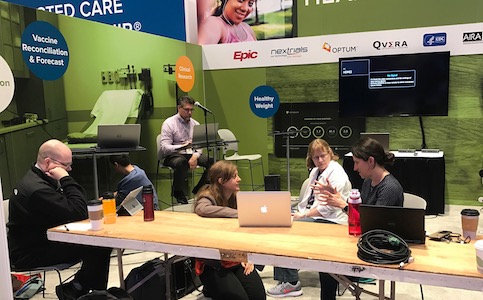
Ian Painter, UW Faculty, Lauren Snyder, UW PhD student, Genny from CDC/NIOSH, and Aly from CDC/NCCDPHP work to tune both story and data.

Federal, State and Non-profit public health partners in this use case.
HIMSS had something over 40,000 attendees. Every year a new record. This was a record for the IHE Showcase as well; I believe I heard that 10-15% of the entire HIMSS crowd came through the Showcase.
We demonstrated an application integrated with the provider version of Epic using "SMART on FHIR". I understood from Epic that these protocols can be used on Epic 2015 or later implementations. SMART on FHIR has also been adopted by Cerner, GE, and others. I heard from Cerner that it can be used in production now, but it will become standard with their MACRA package, due out in 2017/18. So, SMART on FHIR is real.
This is big news for a lot of the work we do in the Clinical Informatics Research group. cPRO is a PRO platform developed by CIRG, and used in products like PainTracker, mPOWEr, the ePRO HIV PROs, a new Prostate Cancer PRO/intervention framework - TrueNTH, and proposed for an integrated heart failure project. With SMART on FHIR, we can insert provider interfaces for those applications as a tab into EpicCare, and we can insert patient interfaces for those applications into Epic MyChart.
This demonstration was driven by CDC, and focussed in bringing patient-specific health weight guidelines into Epic - blending public health knowledge with individual patient data from epic to help providers facilitate behavior change. The clinical data from Epic were height, weight, demographics, and some behavioral risk data. The public health decision knowledge were normative obesity data by gender, occupation, and exercise level, and occupation-specific patient education materials. The goal was to demonstrate providing tailored information to the provider, during the clinic, to support identifying the most productive health behavior to change, and to give the provider tailored information for the patient to support that change. That's an extensible concept. Here are a few ideas:
Longitudinal assessment, Rx for a self management intervention, and integration with statewide PDMP opiate data…
Patient self assessment of wound healing and wound photographs and facilitated communication with providers (mPOWEr)
Rich patient reported outcomes (multi-instrument longitudinal assessments of patients in HIV, oncology, heart failure..)
Longitudinal functional assessment in the post-total joint replacement patient, with linkages to normative recovery trajectories